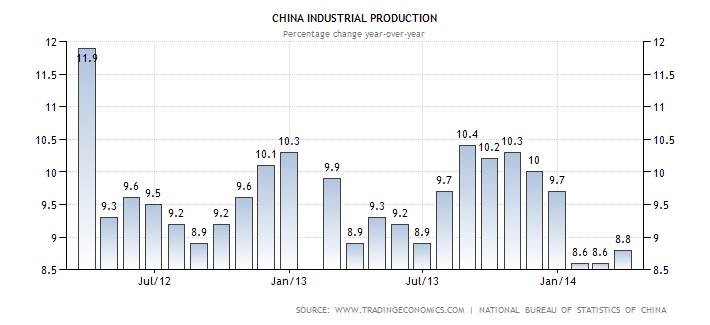The Aussie dollar jumped after China GDP figures for the March quarter came in slightly ahead of expectations around lunchtime yesterday.
That was after it had drifted lower ahead of the release of the data.
The figures showed the economy grew 7.4% year-on-year against the 7.3% market consensus forecast.
It slowed from 7.7% annual rate in the December quarter and was the slowest annual quarterly growth rate since 2012.
The figures brought forward some analysts who reckon the economy will slowly accelerate over the rest of this year.
But the result confused traders in the Aussie dollar – it blipped higher, then fell and then rose to trade around 93.70 USc in late trading in Asia yesterday.
It was trading around this level this morning in Asia after Wall Street had another solid day’s trading. Gold edged higher, oil was steady.
.png)
The weak figures from China had little fallout in the markets.
In fact the result from China wasn’t the load of misery that many bearish analysts had forecast – it wasn’t boom time either, but it showed an economy muddling along, much like ours.
That was best shown by the quarter on quarter growth rate in the three months to March of 1.4%, down from 1.8% in the three months to December.
Weak to falling exports and imports also suggest an economy stuttering along, as do those surveys of manufacturing and service sector activity.
But as we point out in the story on BHP and Fortescue, that didn’t stop China from boosting iron ore imports in the quarter by around 19%, compared to a year ago.
But there are still definite financial weakpoints in China in over extended investors, especially in property and some commodities, local governments running short of funds, banks with rising bad debts and weak demand for some products.
A slow start for the year is not uncommon, due to the Lunar New Year holiday and its timing (in either January or February) when many businesses and factories shut down operations for about two weeks. Companies bring forward imports and exports, distorting trade statistics for two or three months – from December through March and April.
But the flow of recent data from the manufacturing and trade sectors have been weak, raising fears of a sharper slowdown, perhaps accompanied by a credit crisis and financial slump.
That’s why industrial production slowed to an annual growth rate of 8.8% in March, a five year low. But the growth rate over the three months picked up to 8.7% from the 8.6% reported for February and January of this year.

Most forecasts see the Chinese economy growing by 7.4% this year, just under the official target of 7.5%.
The AMP’s Dr Shane Oliver said yesterday that the "Chinese activity data for the March quarter and March were broadly in line with expectations".
"GDP growth at 7.4% year on year confirmed the Chinese growth slowdown that had widely been foreshadowed by a range of economic indicators, but it was slightly stronger than market expectations for a 7.3% gain and fears for much worse.
"While, March GDP growth was just 1.4% quarter on quarter (or just 5.6% annualised), which is the lowest since the March quarter 2012, this is likely to be the low point for this year.
"For the last two years growth has picked up after a weak first quarter, momentum in both industrial production and retail sales already appears to have started to pick up in March and policy fine tuning is likely to help as well.
"As such, Chinese growth remains on track to come in around 7.5% this year. This should be positive for the Chinese share market which with a forward PE of 8.5 times is priced for a hard landing and credit crisis. Its also likely to be supportive for Australian resources stocks,” Dr Oliver said.
And analysts at TD Securities made perhaps the best point of all – they pointed out that as China’s growth has slowed, Chinese demand for Australian commodity exports has grown.
"Slowing Chinese GDP growth may dampen spot commodity sentiment, but bears little resemblance with accelerating commodity imports from Australia (primarily iron ore) in recent years.
"When Australia’s newly-expanded LNG capacity comes on stream from the end of the this year, gas imports will represent a structural jump higher as well as provide growth.
"We remain of the view that a “Chinese slowdown” in headline GDP does not necessarily dampen demand for hard (and soft) commodities,” TD Securities said.
According to the BBC, Julian Evans-Pritchard from Capital Economics said, "Chinese growth held up better than expected last quarter and there are signs that downwards pressure on growth has eased somewhat".
"While Q1 GDP growth slowed, we believe that the growth momentum has stabilised in March. Port throughput data and our field study also suggest that China’s trade may have bottomed out, and will become more resilient than what the current headline numbers suggest," said Zhou Hao who covers the Chinese economy for ANZ in Shanghai.
And besides the simmering financial strains in the economy and financial system, here’s a set of statistics from yesterday’s release that western economists have broken out for analysis.
There was a 27% fall in residential property construction in the quarter, which could suggest that a property crunch is underway.
There are also reports of finished houses and apartments being offered for sale at substantial discounts.
ANZ economists in China said the fall was the major factor in the weak 7.4% annual growth rate (and the fall in quarter on quarter growth to 1.4% from 1.8%).
China’s National Bureau of Statistics figures said residential sales fell 7.7% in the first quarter, compared to the same time last year.
Sluggish sales appear to have triggered a slump in buildings under construction, while the number of new homes waiting to be sold is up 23% from the same time last year.
That could be the real reason for concern about China.













